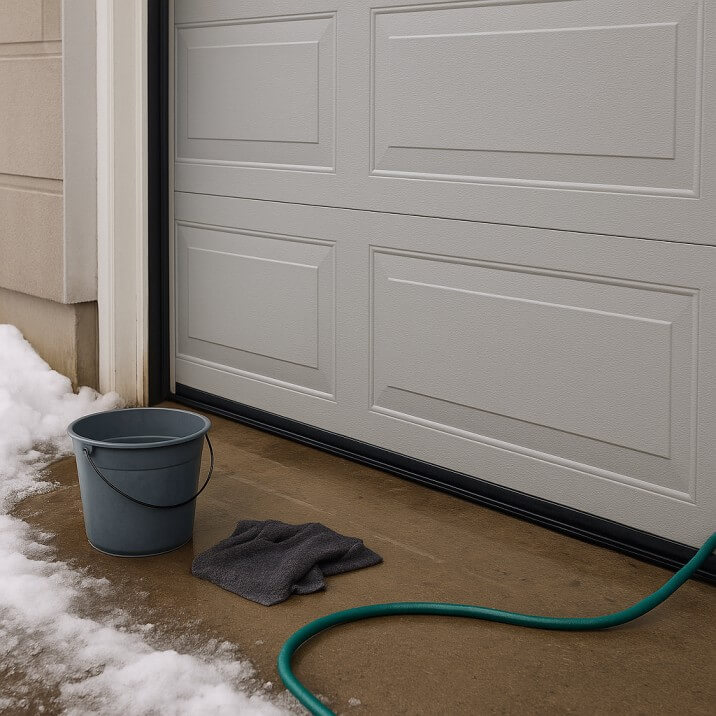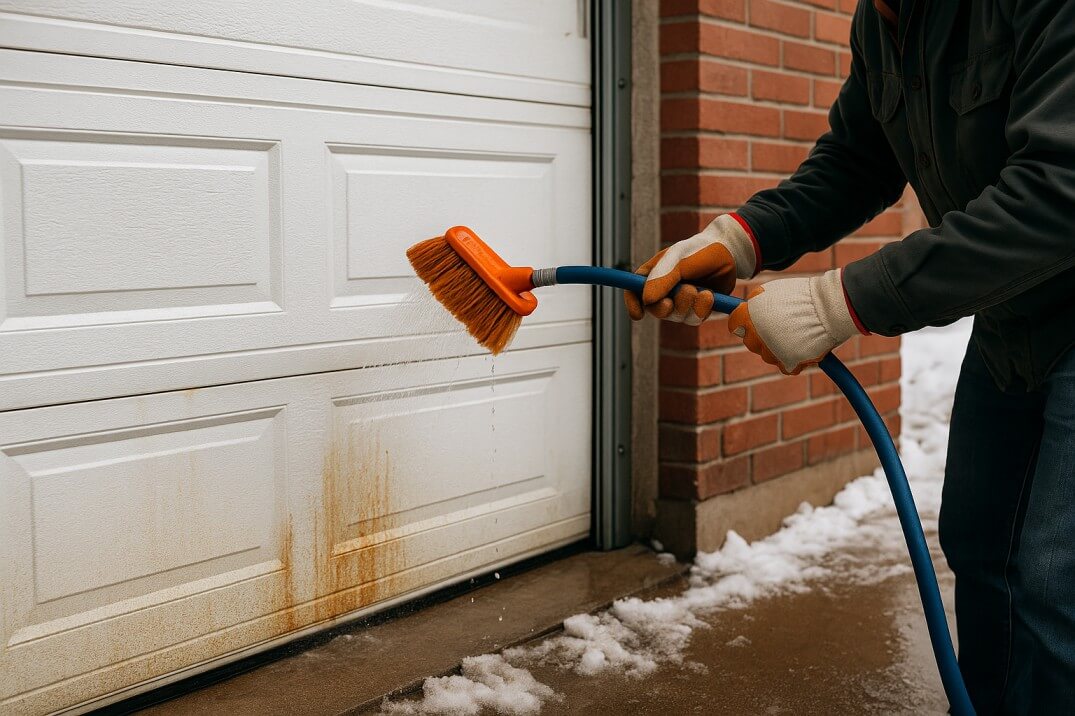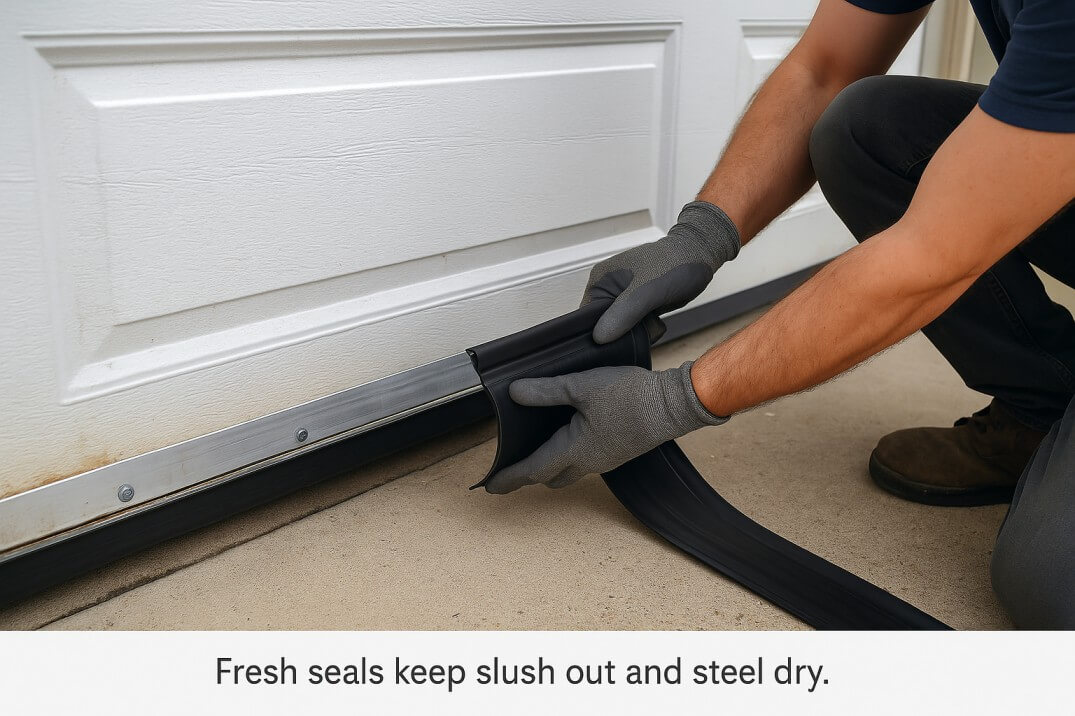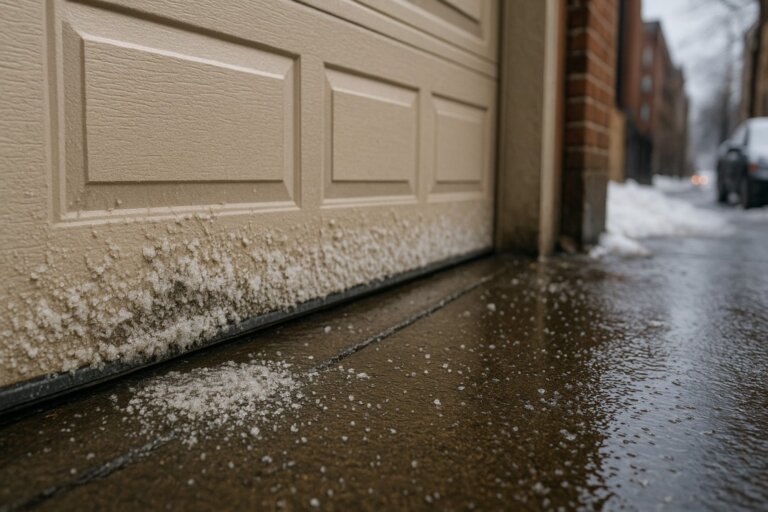New York City winters bring more than just snow and cold temperatures. The combination of road salt, slush splashing from busy streets, and repeated freeze–thaw cycles creates the perfect storm for garage door corrosion. What starts as minor surface rust in December can turn into flaking paint and structural damage by March, leaving homeowners facing expensive spring repairs.
The good news? Rust prevention is far cheaper than panel replacement. With regular cleaning, protective coatings, and strategic maintenance, you can extend your garage door’s lifespan by years even in NYC’s harsh winter conditions. Whether you’re dealing with a residential garage in Brooklyn or a commercial roll-up in Queens, understanding how salt accelerates corrosion—and what you can do about it—protects your investment.
Ready to safeguard your garage door this winter? Book a winter rust inspection with our team, or explore our garage door services in New York to get ahead of the season.
Why Rust Spikes in NYC Winters
Corrosion isn’t just a cosmetic issue. It’s an electrochemical reaction that accelerates dramatically when three elements combine: metal, oxygen, and moisture. NYC winters deliver all three in abundance, with road salt acting as a powerful catalyst that keeps the corrosion process running at full speed.
When municipal salt trucks spray sodium chloride and calcium chloride across city streets, that salt doesn’t stay on the pavement. Vehicles carry salt-laden slush into driveways and spray it against garage doors with every entry and exit. The chloride ions in road salt are hygroscopic, meaning they attract and hold moisture against metal surfaces even when the air feels dry. This persistent dampness creates nonstop oxidation—especially on the bottom 12–18 inches of the door where exposure is heaviest.
The freeze–thaw cycle compounds the problem: water seeps into microscopic scratches and paint chips during warmer hours, then expands when temperatures drop overnight, opening cracks and exposing fresh bare metal to salt and moisture.
Coastal areas of Long Island face an additional challenge beyond road salt. Sea salt carried on winter winds adds to the corrosive burden. For comprehensive strategies addressing both urban and coastal exposure, see our guides on preventing garage door rust in urban areas and protecting against coastal salt air.
Older garage doors with uncoated steel construction are especially vulnerable. Many doors manufactured before the 2000s lack factory powder coating or galvanized protection. Cut edges around hinges, unsealed fastener holes, and the bottom panel’s leading edge become rust hotspots.
Early Signs of Corrosion to Catch Now
Surface Rust on Bottom Sections and Track Feet
The most common early warning sign appears as fine orange or brown dust on the door’s bottom section. Run your hand along the bottom edge of the lowest panel and the corners along the weatherstrip. Don’t forget the track feet near the floor where salt slush pools.
Bubbling or Peeling Paint and Orange Streaks at Hinges
Paint that bubbles or peels signals rust forming underneath, often around hinge attachments. Orange streaks down from hinges, roller brackets, or fasteners indicate active corrosion migrating from hardware.
Stiff Hinges, Noisy Rollers, and Floor Staining
Operational changes often show up before visible rust. Hinges that don’t pivot smoothly, rollers that squeak or grind, or dark staining on the floor beneath the door all point to corrosion.
If you notice these warning signs, act now. See our before and after rust repair gallery or request garage door repair in NYC if damage has progressed.
Don’t let winter salt destroy your garage door. Stop corrosion before it spreads.
Step-by-Step Winter Cleaning Routine (NYC Safe)
Follow this routine every 2–3 weeks during active salting (Dec–Mar):
- Rinse with lukewarm water and mild detergent. Avoid pressure washing in sub-freezing temps. Focus on the bottom section and areas with visible salt film.
- Brush off salt film thoroughly. Use a soft brush or microfiber on the bottom 12–18 inches, corners, hinge areas, and track bases.
- Dry completely to prevent flash rust. Towel dry and allow a few minutes of airflow with the door open. Don’t trap moisture by closing immediately.
- Neutralize remaining chlorides (optional but recommended). Apply a salt neutralizer per label; wipe after 1–2 minutes.
- Lubricate moving parts. Light coat of silicone or lithium garage-rated lubricant on hinges, roller bearings, and springs (avoid opener rails and sensor lenses). Never use WD-40.
- Clean and condition weatherstripping. Wipe rubber seals and condition to prevent cracking.
- Check drainage. Clear threshold drains; confirm floor slopes outward to avoid standing slush.
Pro tip: Use calcium chloride near the garage entrance instead of rock salt. It’s less corrosive and works in lower temps.
For deeper prep, see our NYC garage door winterization checklist and complete weatherproofing guide. Need help? Explore our garage door services in New York.

Protective Coatings and Treatments That Work
Factory powder-coated or multi-layer painted steel offers the best baseline. Spot-prime chips immediately before rust starts.
Zinc-rich primer + rust-inhibiting enamel is the correct touch-up stack. Clean to bare metal, prime with zinc, then topcoat with quality enamel.
Automotive wax or paint sealants add a hydrophobic layer—apply in fall and refresh mid-winter.
Hardware-specific corrosion inhibitors (e.g., T-9, Fluid Film, LPS 3) protect hinges, roller shafts, brackets, and bolts. Keep off sensors and painted faces.
Material upgrades for replacements: galvanized steel, aluminum (no rust), or vinyl-clad steel for heavy urban exposure.
Considering a replacement? Explore rust-resistant doors and pro coatings.
| Salt Problem | Effect on Door | Prevention Strategy |
|---|---|---|
| Road salt spray from passing vehicles | Salt film on bottom panels accelerates oxidation | Rinse every 2–3 weeks; apply wax/sealant in fall |
| Slush pooling at garage threshold | Concentrated chloride exposure at bottom seal/edge | Improve drainage; prefer calcium chloride over rock salt |
| Salt air from coastal exposure | Attacks hardware and cut edges even without splash | Use inhibitors on hardware; seal chips immediately |
| Freeze–thaw expansion | Opens paint cracks and exposes fresh metal | Touch up chips before winter; maintain tight weatherstrips |
| Persistent dampness (salt is hygroscopic) | Continuous oxidation even when surface looks dry | Neutralize chlorides; lubricate to displace moisture |
When DIY Isn’t Enough — Call a Pro
Call immediately for deep pitting, flaking at the bottom rail, rust around hinge mounts, seized rollers/cables, or if the door drags or won’t seal.
What pros do: full neutralization of chlorides, proper sanding/prep, zinc-rich priming and topcoat, stainless/zinc hardware upgrades, new seals, and drainage guidance. We also check spring tension, limits, sensor alignment, and auto-reverse during service.
Book a winter rust inspection today, or check our current winter specials. Long Island customers: ask about our safety inspections with corrosion assessment.
We protect doors across Queens, Brooklyn, Great Neck, Five Towns, and Long Beach with same-day service and stocked vehicles for one-visit repairs.
Long-Term Prevention Plan (NYC/LI)
- Fall prep: Schedule inspection in Oct–Nov for paint touch-ups, inhibitor application, and seal verification.
- Winter cycle: Repeat clean/lube every 2–3 weeks; replace the bottom seal if brittle or gapped.
- Parking habits: Knock slush off wheel wells; use containment mats just inside the threshold.
- Strategic upgrades: stainless fasteners, heavy-duty bulb seals, insulated doors, coastal packages.
- Annual tune-up (spring): post-winter check and adjustments; priority plans available.
Check services in Five Towns and Long Beach, and read more on preventing salt-air damage.
- Inspect bottom section for orange discoloration/roughness
- Check hardware mounts for paint bubbles or streaks
- Test balance; listen for grinding/squeaking
- Verify weatherstrips seal fully with no gaps
- Look for rust staining on the floor beneath the door
Conclusion
Salt and slush are unavoidable in NYC, but rust damage isn’t. Regular cleaning, protective coatings, and professional tune-ups extend door life and prevent costly emergencies. Don’t wait until spring to discover winter damage.
Ready to protect your garage door? Stay ahead of salt and slush this winter.
Schedule winter rust inspection See winter specials Contact our office
Why choose us: licensed & insured • same-day NYC/LI • stocked trucks • warranty on parts & labor • proven results. Read customer testimonials.


FAQ — Winter Rust Protection for NYC Garage Doors
Why does road salt cause rust on garage doors?
Chloride salts attract and hold moisture against metal surfaces, dramatically accelerating the oxidation process that creates rust. In NYC winters, salt-laden slush and freeze–thaw cycles keep metal components constantly wet, turning slow corrosion into rapid deterioration on panels, hinges, and hardware.
How often should I clean my garage door in winter in NYC?
Rinse and wipe down the bottom section and all hardware every two to three weeks during active salting (Dec–Mar). After heavy storms or extended salting, increase frequency. Always dry thoroughly and reapply a light coat of garage-safe lubricant to hinges and rollers.
What coatings actually stop rust from coming back?
For touch-ups, use zinc-rich primer followed by a rust-inhibiting enamel topcoat. Wax or paint sealants help shed slush on painted doors. Factory powder coating is the most durable—seal chips or scratches as soon as they appear.
Can aluminum or vinyl-clad doors rust?
Aluminum doesn’t rust, but it can corrode in salt air. Vinyl-clad steel resists surface rust, but cut edges and steel hardware can still corrode. Regular cleaning and hardware protection are essential for any material.
Is calcium chloride safer than rock salt near my garage?
Yes—calcium chloride is less corrosive and works at lower temperatures. Use sparingly and keep it off sensor lenses and weatherstripping.
When should I replace the bottom seal?
Replace when it’s brittle, cracked, or no longer seals against the slab. In NYC’s climate, expect every 1–3 years. A failing seal lets salt slush infiltrate and accelerates interior corrosion.
When is corrosion too severe for DIY touch-ups?
If you see deep pitting, flaking metal near hinge mounts or the bottom edge, or the door binds, drags, or won’t seal, schedule a professional inspection—structural corrosion often requires panel repair or replacement.
